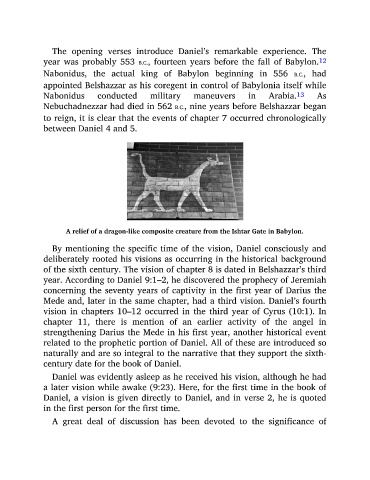Page 181 - Daniel
P. 181
The opening verses introduce Daniel’s remarkable experience. The
year was probably 553 B.C., fourteen years before the fall of Babylon. 12
Nabonidus, the actual king of Babylon beginning in 556 B.C., had
appointed Belshazzar as his coregent in control of Babylonia itself while
13
Nabonidus conducted military maneuvers in Arabia. As
Nebuchadnezzar had died in 562 B.C., nine years before Belshazzar began
to reign, it is clear that the events of chapter 7 occurred chronologically
between Daniel 4 and 5.
A relief of a dragon-like composite creature from the Ishtar Gate in Babylon.
By mentioning the specific time of the vision, Daniel consciously and
deliberately rooted his visions as occurring in the historical background
of the sixth century. The vision of chapter 8 is dated in Belshazzar’s third
year. According to Daniel 9:1–2, he discovered the prophecy of Jeremiah
concerning the seventy years of captivity in the first year of Darius the
Mede and, later in the same chapter, had a third vision. Daniel’s fourth
vision in chapters 10–12 occurred in the third year of Cyrus (10:1). In
chapter 11, there is mention of an earlier activity of the angel in
strengthening Darius the Mede in his first year, another historical event
related to the prophetic portion of Daniel. All of these are introduced so
naturally and are so integral to the narrative that they support the sixth-
century date for the book of Daniel.
Daniel was evidently asleep as he received his vision, although he had
a later vision while awake (9:23). Here, for the first time in the book of
Daniel, a vision is given directly to Daniel, and in verse 2, he is quoted
in the first person for the first time.
A great deal of discussion has been devoted to the significance of

